
Magazine Ratings
Location: Flinders, VIC
Established: 1903
Architect: Dr. James Barrett & David Maxwell (1903) / Alister Mackenzie (1926) / Vern Morcom (1950) / Course Staff (Ongoing)
Played: 2nd April 2017

57 (Current)
After hearing such great things about Flinders Golf Club, we decided to make the journey south. The club is located on the eastern side of Mornington Peninsula, most of the more popular courses are on the western side. This is ranked as a Top 100 course, but in the Public access list only.

Flinders Golf Club Entrance
The course started around 1869 as a four roughly cut holes along the coastline, developed by English and Scottish immigrants. When David Maxwell visited (from what would be eventually known as Royal Melbourne Golf Club), he was enthusiastic and developed two further holes. By 1903 a full eighteen had been developed. In 1926 Dr Alister Mackenzie visited the site, developing a plan for some substantial changes. The club rejected some, but did not have the money to implement the others immediately. Over time, finance was raised and the most significant change put forward by Mackenzie found its way onto the course.

Clubhouse at Flinders Golf Club
Sitting built into a hill, is the modest clubhouse. A nice big balcony is available, which does have sweeping views over parts of the course and also the coastline.

Flinders Golf Club Course Map
Built along public land along the coast line, there is a road running through the course in parts, so be cautious of the cars. There are a few people walking near the course, with children and dogs, but when getting up to the sixth hole you may see hang gliders leaving the cliff tops.

Scorecard for Flinders Golf Club
James and I had entered the local competition of the day, so play was from the white markers. The embarrassing part was winning the comp by ten shots. Had to take the bandit mask off when leaving the club.

Hole 1 – 218 meter par 4 – Maxwell
To start the round, the shortest par 4 and easiest index hole on the course. An elevated tee sits beside the clubhouse for the first shot, with the hole playing relatively straight. There is the choice of aiming for the green or laying up to the wider section of the fairway.

View from the 1st fairway
The green complex is heavily guarded along the front with five bunkers. A small opening is available between these, but a small section of rough is found, which will prevent running the ball into the green. The putting surface slopes mainly from back to front. A nice hole to ease into the round, offering risk verse reward from the tee.

Hole 2 – 290 meter par 4 – St Andrews
Heading is the same direction is another short par 4, although this plays with a slight turn to the right. Out of bounds is found down the left side, with a public road running alongside. A fairway trap is found to the right, although this isn’t the ideal side to be playing.

James playing beside the 2nd fairway
Was this in bounds? Very good question, but surely a difficult shot to try and recover from.

Looking into the 2nd green
A narrow entrance to the green awaits, between two bunkers. This widens dramatically towards the rear. Being down the left side of the fairway offers the best angle into the green, although left pin positions might be more accessible from the center to right. Sitting elevated this is not a big green to land the ball. A lot more testing than the first hole, in particular the approach. Some though required in where to position the tee shot, leaving the best angle for the approach.

Hole 3 – 189 meter par 3 – West Head
Heading west is the longest and hardest index par 3 at Flinders Golf Club. Playing slightly down slope, the fairway short of the green slopes also from right to left.

Down slope to the 3rd green
The putting surface blends in with the fairway at the front, but becomes raised moving towards the rear. There were a few bare patches to the left of the green complex, I believe due to some maintenance work. Distance is the main defense on this hole, as well as potential headwinds, but no easy hole to get par.

Hole 4 – 255 meter par 4 – The Coffin
Still heading in a westerly direction is the signature hole, a short par 4. But you do have to wonder what is install for you with a name like ‘The Coffin’. Even more so how appropriate is the sponsor of the hole. This was one of the holes put forward by MacKenzie during his visit, but it is not known exactly when it was implemented in the years after.

Trouble on either side of the 4th tee
From the tee there is a huge choice to be made. Try and reach the green or lay up to the safety of the fairway. To help the decision is scrub down the left and a road meandering along the right.

Ravine before the 4th fairway
Further to this is a carry over a large ravine, known as the ‘coffin’, before reaching the fairway. Hitting in here and the lie you may have is left to luck. The original hole was a par 3 with the green beyond the coffin ravine.

Approach to the 4th green
This was altered moving the green beyond the next ravine, ‘purgatory’. Makes laying up on the fairway a logical option for me. The green itself slopes strongly from the rear, so keeping under the pin is critical. The hole has no bunkers or water, but is a really enjoyable hole. Great choices from the tee. Finding either of the ravines really makes for a difficult shot. A lot will take on more than they can handle, walking away scratching their head.

Hole 5 – 445 meter par 5 – Beach Hole
The next hole along the coastline is the shortest and easiest index par 5, but there are only two on the course. Playing with a turn to the right, down the left, the road is out of bounds. Three fairway traps staggered on either side await, where the fairway narrows significantly.

View from the 5th fairway
Those long enough will have a chance to reach the green in two, otherwise a decision awaits on where to land the second shot, with three grass bunkers found short of the green.
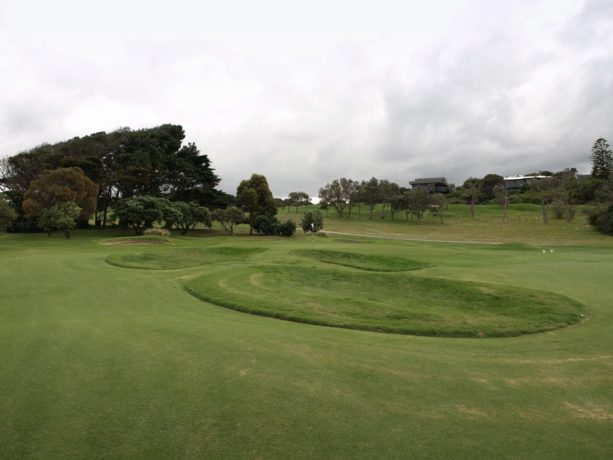
Grass bunkers near the 5th green
Three sand bunkers frame the rear of the green, but I’m not sure how much play these would see. There is ample short grass found around this green, allowing for a variety in the shots played. A decent hole, but the fairway is quite narrow in places, although the surrounding rough is not too penal. The green complex was interesting incorporating grass bunkers short. Most courses, when having a green bunker, will have one, not a complex, so that was something new. There were no real obvious playing lines, with such a narrow fairway. After the previous hole, this was a bit of a letdown.
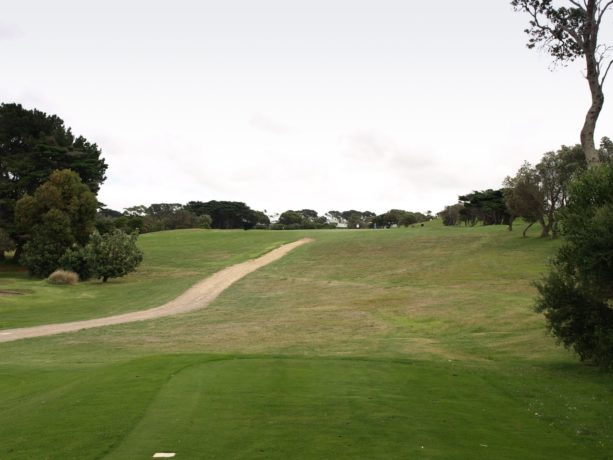
Hole 6 – 338 meter par 4 – The Hill
Coming to the hardest index par 4, this mid length hole has a blind tee shot to the fairway, which sits raised above the tee. Playing with a dogleg to the left, out of bounds is also found down this side. Some slight mounds are also found down the left, helping to keep the ball in play, or more likely reduce damage to passing cars. With the fairway cambering slightly from right to left, it is better to find the center to the right, ensuring the ball remains on the fairway.

View to the 6th green
The green sits on the left edge of the fairway, bringing it close to the road. This side has a sharp drop, leaving a difficult recover, compared to the right, which sits almost level with the fairway. The putting surface is long but narrow, with a large false front, making it a difficult target. Simple design, but effective. There is the option to try and shorten the hole keeping to the left, but bringing in the risk of finding out of bounds. An approach which requires accuracy, but missing to the correct side will allow a decent recovery.

Parasailing beside the 6th green
It is quite easy to get distracted by the parasailing and hang gliders, taking of around the sixth green. Personally quite happy to keep my feet on the ground playing golf.

Hole 7 – 394 meter par 4 – Casuarina
From the most difficult to the longest par 4. The hole is very straight but plays up a gentle slope all the way to the green. Water is found right, for any extremely wayward shots, whilst longer hitters may encounter the right hand fairway bunkers, which offers the better line into the green. The fairway has reasonable width to land the ball.

View of the 7th green
Two bunkers are found on the sides of the green, with the right side being elevated in the mound. the left bunker lip sits raised above the putting surface. There are some strong slopes on the green to contend with, adding to the difficulty on the hole. Playing up a slope makes this play longer than suggested. The fairway is not the widest but does have a preferred line for the approach.

Hole 8 – 324 meter par 4 – Pine Gap
Seeing the name of this hole, conjures visions of large domes in the desert. But on this shorter par 4 with a dogleg left, the gap is in between tall pine trees forming a chute from the tee. At the turn the fairway is quite wide, even with the bunkers found down the left. Playing close to these allows the best angle to the green.
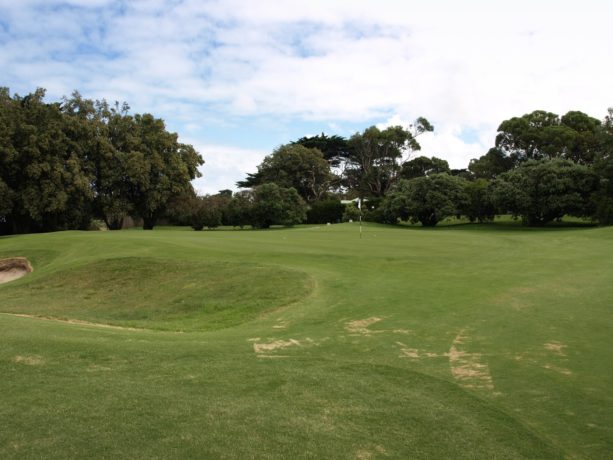
Looking across the 8th green
A line of bunkers lead in on the right side of the fairway, stopping just short of the green. If you have played close to the fairway bunkers, you will avoid having to carry these. A swale followed by two traps is found to the left of the complex though. Really like the design of this hole with well placed hazards, bringing strategy into the hole.
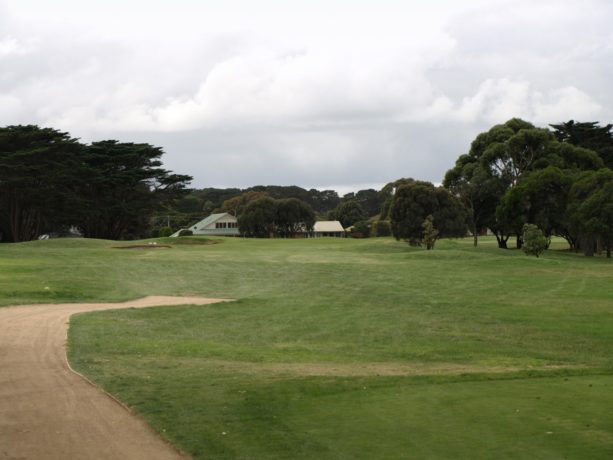
Hole 9 – 162 meter par 3 – Tea House
Finishing the first nine, I won’t say front as this is one continuous loop, is a medium length par 3. Unfortunately there was no little house offering tea, which would be good on a cold windy day. There is quite a lot of short grass leading into this green, which does suggest if you are going to miss, this is the place to do it.
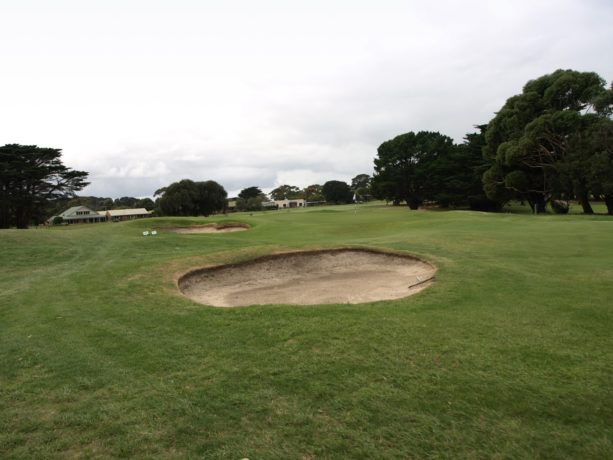
Small trap short of the 9th green
There is a small bunker found short left of the green, whilst two more sit on either side. There are a few contours on the putting surface to contend with and if in the left bunker, the green will be sloping away. Testing hole where the wind may have a big influence. Has some forgiving places to miss, but will punish those who get too aggressive and don’t execute properly.


Hole marker and pin flag
The hole markers suit the course, giving a beach side feel. I love how each shows the hole name. A bold pin flag proudly displays the clubs emblem, whilst the checkers add a little pizzazz.

Hole 10 – 314 meter par 4 – Darley
To start the inward loop is a short par 4 with a slight turn right. The first portion of the fairway is quite wide, although a large Cyprus tree is found on the right, in play for those trying to play close to the green, where the fairway narrows dramatically.

Looking back from the 10th green
An uphill shot to the green, must carry a large front bunker for pin positions to the right, whilst another bunker is left. Some mounds are found near the front, which almost form a grass bunker. The green has a very strong slope from rear to front. There are some risks present on the hole, with a drive close to the left rough, finding a slightly better line into the pin, but overall a fairly simple hole. The main issue will be ensuring the ball is below the pin with such a strong slope on the putting surface.

House beside the 11th tee
A quaint house next to the 11th tee almost give a UK, old World type of feel to the hole, especially with the stone wall surrounding.
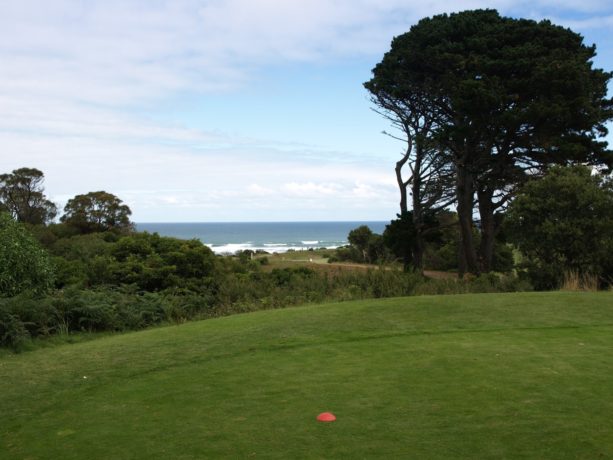
Hole 11 – 257 meter par 4 – Fairy Dell
Heading down the hill is this short par 4, which requires a small carry over a dell before reaching the fairway. With a dogleg to the right, there are numerous bunkers to avoid in the middle of the fairway, left of the green, as well as short in front. One last hazard to avoid is the water beyond the green. This makes for a really risk vs reward trying to reach the green from the tee.

View in from the 11th fairway
With the green angling across the fairway and not so deep, it is best approached from the left side. Two grass bunkers are found at the rear, which will assist in stopping the ball running down into the water hazard.

Looking back at the 11th hole
Although trying to reach the green is too much of a risk, there other options which can reward. Landing between the green and fairway traps offers a short pitch or chip, but still has a high degree of risk. The safe option is left of the fairway traps, although finding the end of the fairway still offers a great angle to the green.

Hole 12 – 125 meter par 3 – Aunt Sally
Still playing down hill is the shortest and easiest index par 3 at Flinders Golf Club, which happens to also be the signature hole. Left of the green is out of bounds, where housing exists. With the land also sloping left to right, a small bunker has been placed on the hill to make it difficult to run balls in from this side. Two further traps are found either side to the entrance, but do leave a reasonable gap, whilst another trap is left of the green.

Short leaves a difficult shot into the 12th green
The putting surface is long, but still has some width, with a few contours to contend with. Anything right of the green will run away down the slope. With it being quite open on the surrounds, the elements will come into play. On our day of play a strong easterly was blowing, making this hole much longer than its suggested distance, making this a lot more difficult.

Hole 13 – 343 meter par 4 – Racecourse
From an elevated tee, this medium length par 4 has a dogleg left. This brings the player back to the lower levels of the course. The trees short of the fairway, make the line look a lot tighter, with a bit of space hidden behind. Two bunkers are found on the outside of the turn, beyond which water is found. Longer hitters will be enticed to cut the corner shortening the hole and also leaving a clearer view to the green.

View from the 13th fairway
A slight rise is found short of the green, so longer hitters may reach allowing a clearer view, short hitters will be left with a blind shot. The green angles away to the left, with a trap noticeable front right and another further along. The putting surface slopes mainly from rear to front and slightly left to right. I was, and still am a little confused on the strategy for this hole. At first I thought the ideal line would be from the right, bunkers are found out here plus the green angles away to the left. Stopping that is the front bunker which basically has to be carried to reach the green, so are the fairway bunkers just to stop rolling into the water? Being left, where taking on the corner brings in risk, the green does not quite sit correctly, with the depth being reduced. Great land for the hole, just not quite sure on hazard placement.
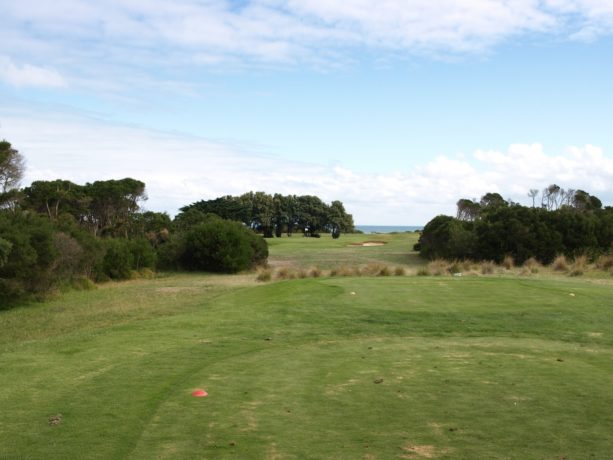
Hole 14 – 129 meter par 4 – Shooting Gallery
Back on the lower land, the next hole is a short par 3. Small trees to the left obscure the left of the green, so there is a bit more room available than first thought. The teeing area is slightly enclosed, but as you near the green this opens up allowing the conditions to come into play.
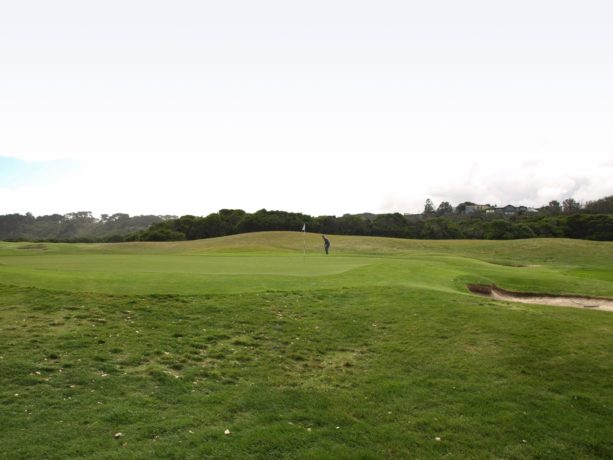
Looking across the 14th green
With quite a large putting surface, there is ample room to land the ball. Two traps frame the entrance, whilst taller trees are found at the rear. I was a bit disappointed with the longer grass on the surrounds, limiting the types of shots available.
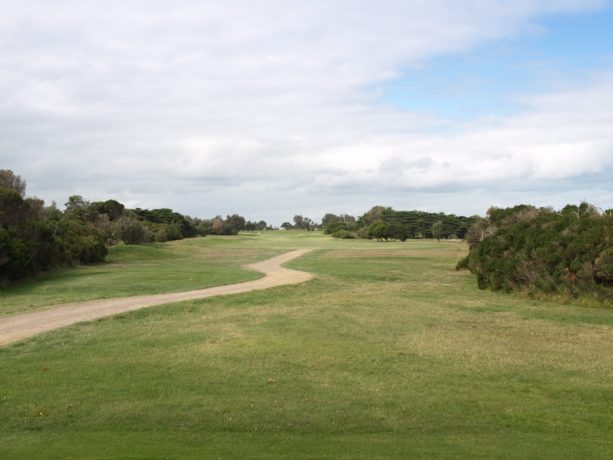
Hole 15 – 486 meter par 5 – Siberia
Next is the longest and hardest index par 5 on the course. The hole is fairly straight, with a large wide fairway available for the drive. Hitting too far right brings the road into play, or more likely the drainage ditch on either side. Bunkers are in play left of the fairway, whilst longer hitters may reach those on the right.

View from the 15th fairway
The fairway narrows beyond the driving area, but opens slightly beyond the right hand fairway trap. Three further traps run diagonally away to the right on the fairway, just short of the green.

Approach to the 15th green
A slightly elevated green awaits, which is reasonable in size. Plenty of short grass is found on the surrounds, with the traps a slight distance away. I do wonder about the names of the hole, this named Siberia. Playing into a strong, slightly cool, headwind, this brings images of a tough environment, so I guess this was appropriately named.

Hole 16 – 298 meter par 4 – Lambertiana
Starting the run home is a short par 4. Cypress trees run down the left, although there is some room between these and the fairway, whilst a row of bunkers run along the right. The ideal line is as far left of the fairway as possible as part of the green angles away to the right.

Cypress trees line the rear of the 16th green
A trap is found on either side of the green, although the right has more impact with the green angling away on this side. The rear slopes away so anything long may face a difficult chip back. Standing on the tee it was obvious the fairway bunkers either should be on the left, or not there at all. With the green position, it truly suits a shot from the left side of the fairway, so there is not point having hazards on the opposite side which don’t really contribute much.

Hole 17 – 159 meter par 3 – Lakeside
The penultimate hole is a mid length par 3, with a small body of water halfway along the hole to the right. Not really in play, so if you find yourself here, it was not a good shot. Another visual aspect that really should not come into play is the large bunker out to the right, which is well short of the green.

View into the 17th green
The main hazards in play will be the bunkers either side of the green and the trees which frame the rear. Ample short grass leads into the hole, so being short is a suitable miss. There are some slight contours to contend with, in particular to the rear. A hole which offers deception, yet allows for a variety of play.

Hole 18 – 290 meter par 4 – Home
Finishing the round is another short par 4, which doglegs to the left, up a hill. For those deciding to layup, there is ample room to land the ball. Those being more aggressive, cutting the corner or playing a longer club take on potential risks.

View from the 18th fairway
Cutting the corner brings into play a bunker to the left or finding trees. Longer clubs may drive through the fairway. Approaching from the left side will open up the green to more pin positions.

Looking back from the 18th green
There are a few mounds surrounding the peanut shaped green, along with two bunkers located on the front right. The surrounds are quite short allowing for a variety of shots, on what is a good closing hole. True risk verse reward is offered, with hazards placed in positions that enhance strategy.
Looking at the course makeup:
- Hole Directions – There was a good variety allowing for conditions to have wide ranging effects during play. All quadrants on the compass were evenly distributed, although no holes were facing direct south. Two holes 16 & 17 have a westerly facing tee, which may have issues late in the afternoon with sun
- Hole Lengths – Being a shorter course there were 5 par 3, 2 par 5 and the remaining par 4 holes. Par three holes had a good variance in distance, the majority in short to mid length. These were fairly evenly spread over both nines. Par four holes ranged from short to long with a clear majority being short. These more than doubled mid to long par 4 holes. These were also evenly spread throughout each nine. Par 5 holes ranged from mid to long with one on each nine
- Hole Layout – There was a decent mixture in how the holes played, with a fairly even spread on how the holes turned, where two shots or more were required to reach the green. The front nine had a majority which turned left
Overall the conditioning of the course was good, especially considering this is a public course. There were no real faults with tees, which were seen to regularly rotate. Fairways were firm but grassed well. The rough could be very patchy in places, with some firm dry spots found at times. Bunkers seemed to be consistent, although I didn’t really manage to play out of many on the day. Green complexes were well maintained, with a fairly firm surface, but the ball rolled a bit slower than expected. This was not a real issue considering the elements which could be experienced on the course.
Some of the short par 4 holes were definitely standouts, in particular 4 and 12. I also enjoyed the 13th par 3. Playing the course is certainly a memorable experience. Taking in some holes along the coast, with the public travelling through in certain areas, gives the impression of UK courses. Even though this is an older design course, it was still challenging, with the elements helping to keep players in check.

I would love to see the plans put forward by Mackenzie for the course and compare to what has been implemented. It is stated changes were made on a couple of holes, but I can’t imagine all have been.
This may not be up to the design standards or conditions to those on the eastern side of the peninsula, but this course is certainly work paying a visit.
How to play at Flinders Golf Course:
1. This is a publicly accessible golf course. Contact the pro shop to arrange a tee time

